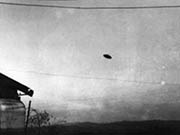UFO: Daylight Disc (DD)

Although called daylight discs (sometimes daylight disks), this type of UFO may be cigar shaped, oval, triangular, or any other geometrical shape. The use of the word "disc" to describe these phenomena sprang from the first sightings after WWII.
June 24, 1947 – The First Documented Post-WWII UFO Sighting
Pilot Kenneth Arnold sighted nine disc-shaped phenomena while flying his private plane near Mount Rainier Washington. Arnold described the discs as "flat like a pie pan... shaped like saucers... half-moon shaped, oval in front and convex in the rear" and in summary said, "...they looked like a big flat disk." Taking its cue from Arnold, the media coined the terms "flying saucers" and "flying disks".2, 3
July 8, 1947 – Daylight Discs Visit a US Air Base
Several daylight discs were sighted by US Air Force personnel at the, then, Muroc Air Base (now Edwards AFB).2
- Two discs were sighted at 9:30 am, judged as moving at a rate of 300 MPH and maintaining a level flight path at 8,000 feet.
- A third disc appeared, flying in "tight circles" and then proceeded towards the Mojave Desert with the first two discs.
- Forty minutes later, a test pilot witnessed a fourth disc also flying north, into the wind.
- At noon, observers witnessed another disc beneath an aircraft, which was flying at 20,000 feet. This disc made a rapid descent and then also flew north. Witnesses described the discs as presenting "a distinct oval-shaped outline, with two projections on the upper surface which might have been thick fins or knobs. They crossed each other at intervals, suggesting either rotation or oscillation of a slow type.... The color was silver, resembling an aluminum-painted fabric."
- At 4 P.M., an F-51 pilot saw a "flat object of a light-reflecting nature" without wings or fins.
Daylight Disc Sightings Spark Government Investigation
Dr. J. Allen Hynek later wrote that it was these sightings cause the Air Force to "take a deep interest in UFOs."3 His speculation was evidenced in that on the day after the Muroc Air Base sightings, July 9, Army Air Force intelligence in conjunction with the FBI began a formal investigation into "selected [UFO] sightings". This and subsequent investigations led to the formation of the Air Force's Project Sign at the end of 1947. Project Sign evolved into Project Grudge, which initiated the well-known Project Blue Book that began in 1952 and continued until 1970.2
Hynek was the lead scientific consultant to the US Air Force Project Blue Book from its inception until its dissolution. After the project was disbanded, Hynek continued in private research. In 1972, he published "The UFO Experience: A Scientific Inquiry". In his book, he outlined his method of UFO classification, including Daylight Disc (DD) as second in his list.5
Is it a Bird, a Plane or a Daylight Disc?
Aside from their appearance, daylight discs are often differentiated from birds or other aircraft by their speed and lack of sound. They hover and then dart off at incredible speed and/or they maneuver at extraordinary angles (such as 90°) with unconventional speed. They may wobble erratically and then quickly achieve a seemingly impossible recovery.
Although they are often described as shiny or metallic, they rarely have a distinct source of light such as traditional aircraft lights or interior lights. The only sound generally reported is a faint "swishing" sound.6
2. “Unidentified flying object .” - Wikipedia, the free encyclopedia 29 May 2008. 9 Apr 2008 <http://en.wikipedia.org/wiki/UFO#First_modern_reports>.
3. Editors of Publications International, Ltd. “"UFO Classification".” How Stuff Works . 31 May 2008 <http://science.howstuffworks.com/ufo-classification.htm>.
4. "UFO." Encyclopedia of Science and Religion. Ed. Ray Abruzzi and Michael J. McGandy. Macmillan-Thomson Gale, 2003. eNotes.com. 2006. 31 May, 2008 <http://www.enotes.com/science-religion-encyclopedia/ufo>
5. “The Hynek Methodology.” UFO DNA. 31 May 2008 <http://www.ufodna.com/articles/articles/hynek.htm>.
6. “Daylight Discs.” UFO DNA. 31 May 2008 <http://www.ufodna.com/articles/articles/dd.htm>
